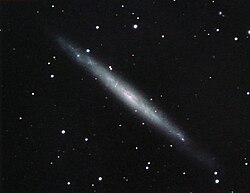A central massive object (CMO) is a high mass object or cluster of objects at the centre of a large star system, such as a galaxy or globular cluster. In the case of the former, the CMO may be a supermassive black hole, a nuclear star cluster, or even both together.[1]
 The star-like nucleus at the centre of this edge-on spiral galaxy, NGC 4244, is a central massive object. | |
The most massive galaxies are thought to always contain a supermassive black hole (SBH); these galaxies do not contain nuclear star clusters, and the CMO is identified with the SBH. Fainter galaxies usually contain a nuclear star cluster (NSC). In most of these galaxies, it is not known whether a supermassive black hole is present, and the CMO is identified with the NSC.[2] A few galaxies, for instance the Milky Way and NGC 4395, are known to contain both a SBH and a NSC.[3]
Although this is suggestive that all galaxies have CMOs, and that a common mechanism of galaxy formation causes both, ESA MIRI scientist Torsten Böker observes that some galaxies appear to have neither SBHs nor NSCs.[4]
The mass associated with CMOs is roughly 0.1–0.3% times the total mass of the galactic bulge.[2]
See also
editReferences
edit- ^ Böker 2010a, p. 61.
- ^ a b Merritt, David (2013). Dynamics and Evolution of Galactic Nuclei. Princeton, NJ: Princeton University Press.
- ^ Nishiyama, S.; Schödel, R. (2012). "Young, Massive Star Candidates Detected throughout the Nuclear Star Cluster of the Milky Way". Astronomy & Astrophysics. 549: A57. arXiv:1210.6125. Bibcode:2012yCat..35490057N. doi:10.1051/0004-6361/201219773. S2CID 17865037.
- ^ Böker 2010b, p. 103.
Bibliography
edit- Böker, Torsten (2010a). "Nuclear star clusters". In de Grijs, Richard; Lépine, Jacques R. D. (eds.). Star Clusters (IAU S266): Basic Galactic Building Blocks Throughout Time and Space. IAU symposium and colloquium proceedings. Vol. 266. Cambridge University Press. ISBN 9780521764995. ISSN 1743-9213.
- Böker, Torsten (2010b). "Young Massive Star Clusters in the Era of the Hubble Space Telescope". In Macchetto, F. Duccio (ed.). The Impact of HST on European Astronomy. Astrophysics and Space Science Proceedings. Springer Science & Business Media. ISBN 9789048134007.